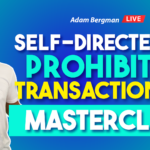In this episode of Adam Talks, IRA Financial’s Adam Bergman Esq. discusses the Backdoor Roth 401(k) and how you can contribute over $70000 to a Roth IRA in one year!
How does one get $70000 in a Roth IRA? Aren’t there contribution limits? What about income restrictions? Yes and yes! The IRS limits how much you can directly contribute to an IRA each year. Plus, if you earn too much money, you are not allowed to contribute to a Roth. But, as Adam talks about in this podcast, there is a way to get over $70000 in a Roth IRA in one year.
Why Go Roth?
We feel the Roth is the best retirement plan out there for most people. To refresh your memory, a Roth IRA contribution does not come with an upfront tax deduction. When you contribute to a traditional retirement plan, those funds are not taxable for the year they were made. Instead, they are tax-deferred until you start withdrawing from the plan. On the other hand, Roth IRA contributions are made with after-tax money, meaning there is no immediate tax benefit. However, all qualified distributions, including any earnings, are tax deductible! A qualified distribution occurs when you reach age 59 1/2, and any Roth IRA has been opened for at least five years. Early withdrawals from an IRA will lead to taxes and an early withdrawal penalty.
Again, Roth IRAs are not for everyone. Some might prefer the tax break afforded by a traditional plan. Although, it nice it diversify the taxation of your retirement plans. Having both a traditional and Roth account is generally the best bet for all. Of course, because of income limitations, not everyone can contribute to a Roth. Generally, that means you might not get a deduction from your traditional contributions either (depending on if you have a workplace plan available to you or your spouse).
Further, IRS rules limit how much you can directly contribute to any IRA. For 2021, you may only contribute up to $6,000, plus an additional $1,000 catch-up contribution if you are at least age 50. To go above and beyond that in a given year, you must utilize the Backdoor Roth strategy.
How to get $70000 in a Roth IRA
Because of the generous limits of the 401(k) plan, you can actually contribute money to one, and if you are lucky enough, you may be able to contribute the maximum allowed by the IRS, and then convert those funds to a Roth IRA immediately.
Here’s how it works:
Pretax (traditional) and after-tax (Roth) are two ways to fund a retirement plan. However, there is a third – the after-tax contribution to a traditional plan. Obviously, since it is after-tax, there is no upfront tax deduction. Plus, if you left those funds in a traditional plan, taxes would be deferred until you withdraw from it. That is the worst possible situation from a tax standpoint. That’s where the backdoor comes into play.
Because this type of contribution to a 401(k) plan is neither an employee deferral nor an employer profit sharing contribution, no triggering event is needed to move those funds from the plan. Normally, you cannot move funds from a 401(k) while you are still working for the company that sponsors it. After-tax contributions to a traditional plan are in their own little “bucket,” as Adam likes to call it. The idea is to contribute those funds to your 401(k) and immediately convert them to a Roth IRA. NO taxes are due, since you’ve already paid them before you made the contribution.
Who Can Do This?
As we said earlier, not everyone can do this. Because of larger 401(k) plan rules, you can only contribute over the normal limit if enough people decide to do so. You won’t find many people at a regular job who are looking to contribute $50000+ to their retirement plan. Therefore, the Backdoor Roth is more geared to the self-employed. If you have a Solo 401(k), there are no strict ERISA tests that you must pass to make these types of contributions. Further, even if you have a full-time job with a retirement plan, you can still open a Solo 401(k) if you have any type of self-employment income.
For 2021, you may contribute up to $58000, plus an additional $6500 if you are at least age 50. $19500 of that is the employee contribution (which can be done by anyone with a 401(k) plan). The rest is the employer contribution, which is based on a percentage of your self-employed income. If you are at least age 50, you can contribute $64,500 to your 401(k), plus $7,000 to your IRA, allowing you to contribute over $70000 in a Roth IRA.
Conclusion
Obviously, this concept is not for everyone. It’s best suited for high-earners, who are also self-employed. But, if you have the means to do so, getting $70000 in a Roth IRA may be the best thing to do for your retirement. This is especially true if you are still young, and can enjoy the benefits of the plan for decades to come. Plus, you can leave your tax-free funds to your beneficiaries when you pass. We strongly consider looking into the Roth IRA by speaking with a financial advisor to see if it suits your needs.
Thanks for listening to another episode of Adam Talks. Just remember, you can find all our podcasts on our SoundCloud page, as Adam drops one every week. Keep listening and saving smart for retirement and we’ll see you next time!









